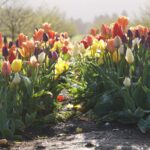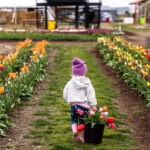
As the last traces of winter begin retreating from the fertile soils and fog-veiled peaks of Washington’s Skagit Valley, an annual awakening commences that sets this rural landscape utterly aglow. The region surrounding the tiny seaside town of La Conner ignites into a blaze of vibrant yellow as over 300 acres of daffodil fields burst into radiant bloom.
This ephemeral botanical phenomenon draws nature lovers from around the globe to chase spring’s golden trail through the valley’s old-growth forests, sweeping farmlands, and salty coastal inlets. For amid the North Cascades’ rugged splendor lies a kaleidoscope of natural treasures and cultural heritage just waiting to be discovered.
Leading the floral vanguard each March is La Conner’s beloved Daffodil Festival – an exuberant rite of spring celebrating the emergence of these sunny harbingers. Visitors can frolic through a blizzard of daffodil petals swirling at the Kiwanis Club’s antic “Daffodil Stomp” or marvel at over 600,000 blooming bulbs carpeting the entrancing RoozenGaarde display garden. Wander backcountry roads and waterways for dreamy shots of windswept daffodil seas set against snowy mountain peaks.
Yet this golden wave heralds just the opening salvo in Skagit’s springtime grandeur. For as the daffodil curtain rises, another breathtaking natural performance takes the stage – the awe-inspiring return of the snow geese. Every March, over 60,000 of these brilliant white nomads descend in hypnotic aerial formations to feed amid the valley’s flaxen fields. Their honks and wingbeats rippling across Fir Island’s sprawling marshes as stately flocks of tundra swans glide the sloughs nearby.
At the junction of these fertile lowlands and Puget Sound’s saltwater reaches, incredible biodiversity abounds amid weathered seaside villages and monumental old-growth forests. Experienced guides lead kayak tours through silent estuaries where eagles perch along shores of improbable green hue. While inland, mist-shrouded trails carve through towering Douglas firs and cedars – the largest specimens in the lush North Cascades wilderness.
For those with stamina, the pinnacle adventure lies in summiting iconic Cascade peaks like Desolation and Sahale for jaw-dropping panoramas of jaw-dropping valleys and snow-etched ridgelines. Whether traversed by boot, paddle, or wing, this remote valley offers natural thrills and sensory revelations at every turn.
Yet the crown jewel of Skagit’s sumptuous springtime remains that fleeting converged majesty when pastoral daffodil drifts waltz with swirling snow geese formations under the watchful gaze of North Cascadian sentinels. It’s nature’s grandest symphony crescendoing for but a brief movement before fading into the vivid green harmonies of summer.
Tulip Fields to Salish Sea: Exploring Skagit Valley’s Springtime Wonders
 As winter’s icy grip releases the Pacific Northwest from its clutches, one fertile corner of the Puget Sound lowlands bursts into a spectacular vernal exhibition. Here in Washington’s Skagit Valley, the renowned La Conner Daffodil Festival heralds the arrival of nature’s delirious springtime crescendo.
As winter’s icy grip releases the Pacific Northwest from its clutches, one fertile corner of the Puget Sound lowlands bursts into a spectacular vernal exhibition. Here in Washington’s Skagit Valley, the renowned La Conner Daffodil Festival heralds the arrival of nature’s delirious springtime crescendo.
For seasoned wildflower adventurers, this narrow isthmus between the North Cascades and Salish Sea represents the opening salvo in a glorious botanical campaign across mountain, forest, and shoreline. One that begins in late March as sunbaked fields from La Conner to Mount Vernon and Sedro-Woolley unfurl into radiant drifts of gold.
Over 300 acres of daffodil plantings choreograph this vibrant warm-up act, transforming Skagit Valley’s patchwork of farmlands into an ocean of fluttering petals. Winding byways like Fir Island Road and La Conner’s waterfront streets become floral thoroughfares where roadside stalls overflow with freshly-picked bunches and daffodil wreaths. Intrepid botanists can even venture off the beaten path into private farms to harvest their own blooms from waving fields.
Yet this is merely the prelude to greater ecological theater set to unfold across the emerald valley in April’s full flush of spring. As the daffodils stretch into full prima donna regalia, another grand spectacle takes flight across Skagit’s pristine waterways and agricultural reserve lands.
Enormous flocks of migratory snow geese descend in breathtaking helical plumes, their white plumage igniting like beacons on glassy ponds and fields. At wildlife havens like Fir Island Farms Reserve, ungainly yet elegant tundra swans glide amidst towering tule reeds as admirers paddle hushed kayak tours at water level. This harmonious confluence of daffodils and waterfowl has earned it the moniker “Festival of Swans.”
But to truly apprehend spring’s full masterwork across this dynamic Pacific Northwest terroir requires an expertly crafted expedition. One that swoops from the daffodil-lined coastal lowlands up through the wildflower-carpeted alpine meadows ringing the craggy North Cascades spires. Here, ambitious wilderness hikers can embark into flowery otherworlds like the Maple Pass Loop or legendary Cascade Pass – azure jewels of the greater Skagit watershed now reawakening with blossoming life.
Just an hour’s drive west delivers you seaside among the secluded coves and rugged driftwood-strewn beaches of the Salish Sea shoreline. Thoughtful foragers scan the rainforest understory for edible mushrooms and salmonberry canes amid sword ferns and moss-cloaked bigleaf maples. Or cast a line from surf-pounded sea stacks for the region’s celebrated freshwater Chinook salmon.
This is the very essence of a true Pacific Northwest spring immersion. One that breathes in the full aromatic bouquet – from cultivated daffodil farms to native woodland shrubs to briny saltwater shores. All woven through a living tapestry bound by the wild, glacial-fed veins of the mighty Skagit River. A definitive naturalist’s pilgrimage that pays tribute to the circle of blooms and migrations catalyzing annually across this incomparable valley of abundance.








